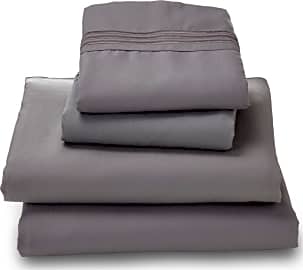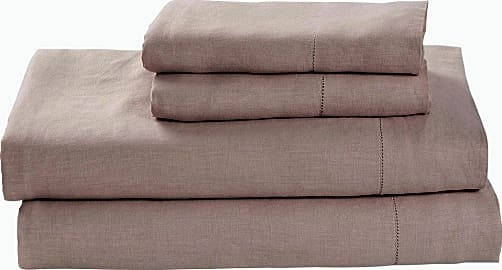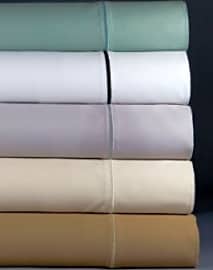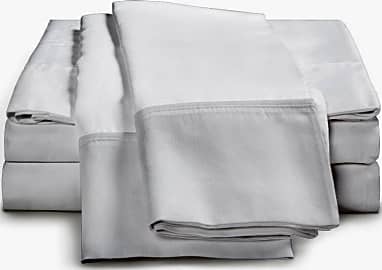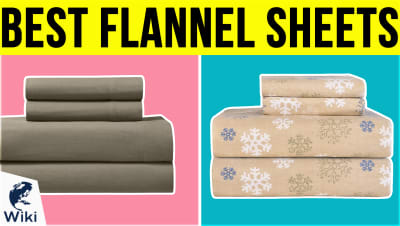The 10 Best Bed Sheets

This wiki has been updated 39 times since it was first published in March of 2015. Your choice of bed sheets can have a significant effect on the quality of your sleep. To find the right set, consider material, texture, thickness, strength, and moisture wicking capabilities. Whether you prefer the smoothness of sateen, the breathability of linen and cotton, or the durability of polyester, our selection has something for you. When users buy our independently chosen editorial selections, we may earn commissions to help fund the Wiki.
Editor's Notes
December 23, 2019:
There’s a lot to consider when you’re in the market for a new set of bed sheets, including their feel, material, fit, overall durability, and price. Some people prefer the softness and warmth of flannel sheets, while others seek out organic sheets, which can reduce the chances of allergic reactions. Our selection here includes these options, as well as those made from a variety of other materials to suit all preferences.
For those who prefer the charming, shabby-chic look of linen, the newly added Stone & Beam Belgian Flax will do the trick. Linen’s breathability makes it a comfortable choice in the summer, yet it can also be insulating enough to keep you warm in colder months, as well. This particular set incorporates an elegant, vintage touch, with decorative hemstitching on each piece. As far as their feel, they actually soften over time as you wash them. You can choose from among soothing colors of Aruba (dark blue), Rose, Natural (beige), Smoke, and Stone. They come in a linen drawstring bag, which can be used to store them or for any other purpose.
The Wamsutta Dream Zone set is another new addition that retain their softness over time, and these are made from pure pima cotton that’s grown in California’s San Joaquin Valley. They’re from a company that has been making linens for 170 years, and their fibers are long and dense to ensure durability. They’ll come out of the washer and dryer free of wrinkles, and when they’re on your bed they’ll stay firmly in place, thanks to the fitted sheet’s wide elastic. They’re backed by a limited lifetime warranty, so you can purchase them with confidence.
Leaving the selection today are the Sferra Grande Hotel, which can become significantly wrinkled, and the Royal Hotel Bedding, which feature seams that can come undone rather easily in the wash.
Special Honors
L.L.Bean 280-Thread-Count Pima Cotton Percale Sheet Set These are woven from long-staple pima cotton yarns, which give them a luxurious, smooth feel that will keep you comfortable all year round. They feature elegant hemstitched details and have a soft texture that won’t cling to the skin. Since they hold up well over time, you can count on them to keep you warm on many a cold, winter night. llbean.com
Threshold Performance Sheet Set These 100% cotton sheets from Target are made of smooth, silky sateen with a 400 thread count. Their patented fit technology keeps them firmly in place on your mattress, and they’re quick and easy to put on your bed, thanks to their top and bottom labels. They won’t wrinkle, pill, or shrink when you wash them, plus they’re bleach friendly for easy care. They’re an affordable choice and come in all standard sizes, plus extra-long twin. target.com
The Sheets Make The Bed
Similarly, a bed sheet thread count is analogous to the metal between the holes on your cheese grater.
Apparently, we spend about a third of our lives asleep. I think I get enough sleep to come closer to about a quarter, but I'm sure we can all think of a few people in our lives who sleep closer to the halfway mark, averaging it out for us more industrial types.
However much time you spend in bed, your comfort depends on two primary factors, the quality of your mattress and the quality of your sheets. But what makes one set of sheets superior to another?
I like to compare sheets to cheese graters. A good cheese grater has a few different calibers of grating on it, allowing you to shred cheeses and veggies into different shapes and sizes. The larger the holes are on a cheese grater, the rougher the surface feels, and the more damage it can do to your skin if you get careless with your grating.
Similarly, a bed sheet thread count is analogous to the metal between the holes on your cheese grater. The higher your thread count, the smaller the spaces between the threads. After all, we're talking about using more fabric across the same dimensions. That means that sheets with a high thread count are like the zesting side of a grater, composed of much smaller holes that are much kinder to your skin.
Of course, the materials in question make a difference as well, as the coefficient of friction differs radically between fabrics like cotton or burlap and more luxurious fabrics like silk.
Pull The Thread
You might well wonder, if an increase in thread count results in a theoretical increase in comfort, why there simply isn't a race among bed sheet manufacturers to the highest possible thread count. The answer here is twofold, and it ought to send you down a specific path toward narrowing our list down to a few ideal options for your sleeping style.
On a final note, make sure that you compare prices across a uniform sheet size.
Firstly, there's the question of cost. Higher thread counts literally translate to more fabric, and more fabric means higher production costs. You pay for that difference in production cost at the register, and our list consists of sheet collections that split the difference between the most absurdly expensive sheets on the market and those more economically produced.
What you're willing to spend on a sheet set will be your first determining factor, then, as our list ranges from the very economical and rather comfortable to bed sheets that could fool even the wealthiest of sleepers for a little extra cost.
Secondly, there's the question of sheer comfort style, with cotton sheets carrying a distinctly different implication with them than silk sheets. Compared to the more breathable cotton sheets on our list, and to the bamboo sheets which are gaining popularity for their comfort, coolness, and durability, silk seems a little bit like yesterday's luxury fabric.
On a final note, make sure that you compare prices across a uniform sheet size. Most of our links connect you to listings for king size sheets, but a few bring up pricing for queen, double, and twin, so make sure you adjust the listing to compare pricing as accurately as possible.
Catching A Lot Of Flax
At some point in the development of mankind, we became a diurnal species, hunting and gathering through the day and sleeping at night. We certainly weren't equipped with the same kind of nocturnal sensory tools as some of the larger predators on the planet, so it makes sense that we would work while they slept and sleep while they worked.
In those days, however, sleep came on the ground with little to nothing for cover, save the occasional animal hide. Along the timeline of human evolution, the bed sheet has only been around for an instant.
The first people to successfully manufacture a kind of bed sheet were the Egyptians, who worked flax into a thread that they wove into fabric by hand.
The first people to successfully manufacture a kind of bed sheet were the Egyptians, who worked flax into a thread that they wove into fabric by hand. The act of weaving, however, reaches back to ancient Turkey. In 2013, archeologists found what they believe to be the oldest piece of woven cloth known to man, dated back to roughly 7000 BCE.
It was the ancient Egyptians, however, who left us a bevvy of evidence both in actual cloth samples and in artworks depicting the act of weaving. The Egyptians weren't alone in their ancient conquest for comfort, however. Around the same time that Egyptian linen weaving more or less standardized, Chinese cultures had begun a similar endeavor utilizing the silk threads produced by select varieties of worm.
Not to keep bashing silk here, but it is worth noting that as an owner of silk sheets, you're essentially sleeping on a pile of worm spit. I just want to reiterate that.
Fast forward 5,000 years, and you come to the great experiment in modern democracy and human slavery called America. One of the primary crops in the US from its earliest colonial days was cotton, and by the early 1800s, the cotton manufacturing industries hit an unprecedented domestic boom. Among such American classic items as the plain white T-shirt and the denim pant, textile manufacturers began to produce cotton bedding, and the legacy of those days persists in a multitude of ways.





